BACKGROUND"Chevron" is an architectural term denoting the rafters of a roof meeting an angle at the upper apex. The chevron in heraldry was employed as a badge of honor to mark the main supporters of the head of the clan or "top of the house" and it came to be used in various forms as an emblem of rank for knights and men-at-arms in feudal days. One legend is that the chevron was awarded to a knight to show he had taken part in capturing a castle, town, or other building, of which the chevron resembled the roofs. It is believed from this resulted its use as an insignia of grade by the military. The lozenge or diamond used to indicate first sergeant is a mark of distinction and was used in heraldry to indicate achievement. METHOD OF WEARINGChevrons were sewn on the sleeves of uniforms with the point down from approximately 1820 to 1903. They were worn with the points both up and down between 1903 and 1905 after the first reversal from "down" to "up" was authorized on 1 May 1903 in Army Regulation No. 622. This confusion period, from 1903 to 1905, was the result of the color change in the chevrons provided for in the regulation which also directed a standard color for each branch, corps, or organization and replaced the gold-colored chevrons. Because of the number of gold insignia available, troops were permitted to wear the old-type chevron until the supply became exhausted. To assure uniformity in both color and position of the new colored chevrons, War Department Circular 61, dated 30 November 1905, stated that the points of the chevrons would be worn points upward. It also provided for the following colors as had been directed in Army Regulation No. 622, dated 1 May 1903. The colors were: Artillery-scarlet; Cavalry-yellow; Engineers-scarlet piped with orange; Hospital Corps-maroon piped with white; Infantry-light blue; Ordnance-black piped with scarlet; Post QM Sergeant-buff; Signal Corps-orange piped with white; West Point Band-light blue; and West Point Detachment-buff. As early as 1820, chevrons were worn with the point down, although there was not an official direction of this to appear in regulations until 1821 when chevrons were authorized for both officers and enlisted men. Circular No. 65, 1821, stated that "Chevrons will designate rank (both of officers through the rank of captain and enlisted men) as follows: Captains, one on each arm, above the elbow, and subalterns, on each arm below the elbow. They will be of gold or silver lace, half an inch wide, conforming in colour to the button of their regiment or corps. The angles of the chevron to point upwards." Adjutants will be designated by an arc of gold or silver fringe, (according to the colour of their trimmings), connecting the extreme points formed by the ends of the chevron. Sergeant Majors and Quartermaster Sergeants will wear one chevron of worsted braid on each arm, above the elbow. Sergeants and senior musicians, one on each arm, below the elbow, and corporals, one on the right arm, above the elbow. They will conform in colour to the button of their regiment or corps." Before this time, an officerís rank was indicated by epaulettes worn on the shoulder. This regulation also indicated the first use of the arc as part of the chevron. Chevrons continued to be worn points downward during the 1800ís. AGO Order No. 10, dated 9 February 1833, stated "Chevrons will be worn with the point toward the cuff of the sleeves." Article 1577 of the revised United States Regulations of 1861 stated "The rank of non-commissioned Officers will be marked by chevrons upon both sleeves of the uniform coat and overcoat, above the elbow, of silk worsted binding on-half inch wide, to be the same color as the edgings of the coat, point down." TITLES OF GRADE 1775 A general order was issued from Headquarters at Cambridge that "Sergeants may be distinguished by an Epaulette or stripe of red cloth, sewed upon the right shoulder; the Corporals by one of green." The organizational charts indicated the enlisted personnel consisted mainly of sergeants, corporals, musicians, and privates. 1776 By early 1776 an approximately standard Continental Infantry Regiment had emerged consisting of a headquarters and eight companies, each company with four sergeants, four corporals, two drummers or fifers and 76 privates. According to the Journals of the Continental Congress, later in that year all battalions were given a non-commissioned headquarters element consisting of a sergeant-major, a quartermaster sergeant, a drum major and a fife major, all to be appointed by the regimental commander. This is the first mention of the rank of sergeant-major. 1792 During this year the military service was expanded to include sergeants-major, quartermaster sergeants, senior musicians, sergeants, corporals, farriers, artificers, saddlers, musicians, trumpeters, dragoons and privates. 1796 Senior musicians disappeared, but principal musicians apparently took their place; farriers and saddlers titles were united; sappers and miners appeared; and trumpeters disappeared. 1799 Principal musicians were succeeded by chief musicians; sappers and miners disappeared; and the titles artificers, saddlers and blacksmiths were combined. 1800 Principal musicians again appeared while chief musician disappeared and the designations of farriers and saddlers, sappers and miners, and a separate title of artificers, were authorized. 1802 Enlisted men were designated sergeants-major, teachers of music, sergeants, corporals, musicians, artificers and privates. 1808 Sergeant-majors, quartermaster sergeants, principal musicians, sergeants, corporals, musicians, artificers, saddlers, farriers and privates were the titles of enlisted personnel. 1812 Blacksmiths and drivers of artillery were added to enlisted grade titles. 1815 Designations of enlisted personnel were again simplified to sergeant-major, quartermaster sergeants, principal musicians, sergeants, corporals, musicians, artificers and privates. 1832 During this year the designation "enlisted men for ordnance" appeared. 1833 The designations of chief bugler, bugler, farrier and blacksmith were additional titles during the year. 1838 The title "enlisted men for ordnance" was changed to "enlisted men of ordnance". 1847 The title of principal or chief musician, principal teamster and teamster were added to the list. 1855 The title of ordnance sergeants came into being. 1861 During the Civil War, many new designations came into being. The following is a complete list of designations: sergeant majors; quartermaster sergeants; commissary sergeants; leaders of bands; principal or chief musicians; chief buglers; medical cadets; ordnance sergeants; hospital stewards; regimental hospital stewards; battalion sergeant majors; battalion quartermaster sergeants; battalion hospital stewards; battalion saddler sergeants; battalion commissary sergeants; battalion veterinary sergeants; first sergeants; company quartermaster sergeants; sergeants; corporals; buglers; musicians; farriers and blacksmiths; artificers; saddlers; master wagoners; wagoners; privates; enlisted men of ordnance. 1866 The following titles disappeared: leaders of bands; battalion hospital stewards; chief buglers; medical cadets; battalion commissary sergeants; battalion saddler sergeants, battalion veterinary sergeants; buglers; and enlisted men of ordnance. The following new titles were established: saddler sergeants; trumpeters, chief trumpeters; privates (first class); and privates (second class). 1869 The title chief musician again appeared and a first sergeant in the corps of engineers was established. 1889 Post quartermaster sergeants, private hospital corps, general service clerks and general service messengers were established. 1899 Electrician sergeants, sergeants first class, drum majors, stable sergeants, mechanics and cooks were established. 1901 The title post commissary sergeant, regimental commissary sergeant, and color sergeant were established. 1905-1919 The designs and titles varied by branch and there were 45 different insignia descriptions in specification 760, dated 31 May 1905, with different colors for different branches. General Order No. 169 dated 14 August 1907 created a wide variety of insignia. Specific pay grades were not yet in use by the Army and their pay rate was based on title. The pay scale approved in 1908 ranged from $13 for a private in the engineers to $75 for a Master Signal Electrician. The system identified the job assignment of the individual, e.g., cooks, mechanics, etc. By the end of World War I, there were 128 different insignia designs in the supply system. 1919 Prior to 1919, the insignia of private first class consisted of the insignia of the branch of service without any arcs or chevrons. The Secretary of War approved "an arc of one bar" for privates first class on 22 July 1919. 1920 The number of insignia was reduced to seven and six pay grades were established. War Department Circular No. 303, dated 5 August 1920, stated the chevrons would be worn on the left sleeve, point up, and to be made of olive drab material on a background of dark blue. The designs and titles were as follows: Master Sergeant (First Grade): Three chevrons, and an arc of three bars, the upper bar of arc forming a tie to the lower chevron. Technical Sergeant (Second Grade): Three chevrons, and an arc of two bars, the upper bar of arc forming a tie to the lower chevron. First Sergeant (Second Grade): Three chevrons, and an arc of two bars, the upper bar of arc forming a tie to the lower chevron. In the angle between lower chevron and upper bar a lozenge. Staff Sergeant (Third Grade): Three chevrons and an arc of one bar, forming a tie to the lower chevron. Sergeant (Fourth Grade): Three chevrons. Corporal (Fifth Grade): Two chevrons. Privates First Class (Sixth Grade): One chevron. 1942 The grades of Technician in the third, fourth and fifth grades were added by War Department Circular No. 5, dated 8 January 1942. Change 1 to AR 600-35, dated 4 September 1942, added a letter "T" to the formerly prescribed chevrons for grades three, four and five. The first sergeant was moved from the second grade to the first grade per Change 3, AR 600-35, dated 22 September 1942. This change described the first sergeantís chevron as - - Three chevrons and arc of three bars, the upper bar of arc forming a tie to the lower chevron. In the angle between lower chevrons and upper bar, a hollow lozenge. This change also included the material as khaki chevrons, arcs, T, and lozenge on dark blue cotton background or olive-drab wool chevrons, arcs, T, and lozenge on dark blue wool backgrounds. 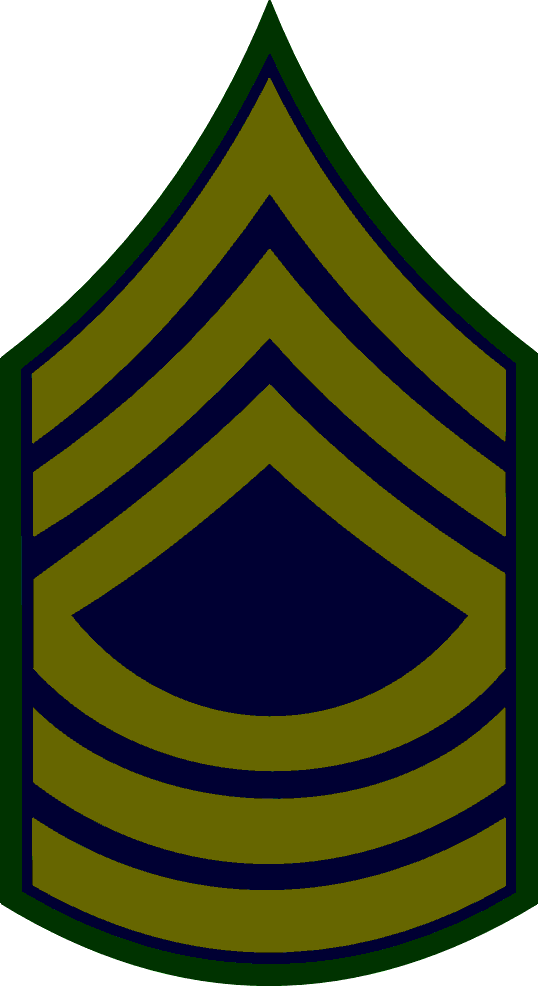
| 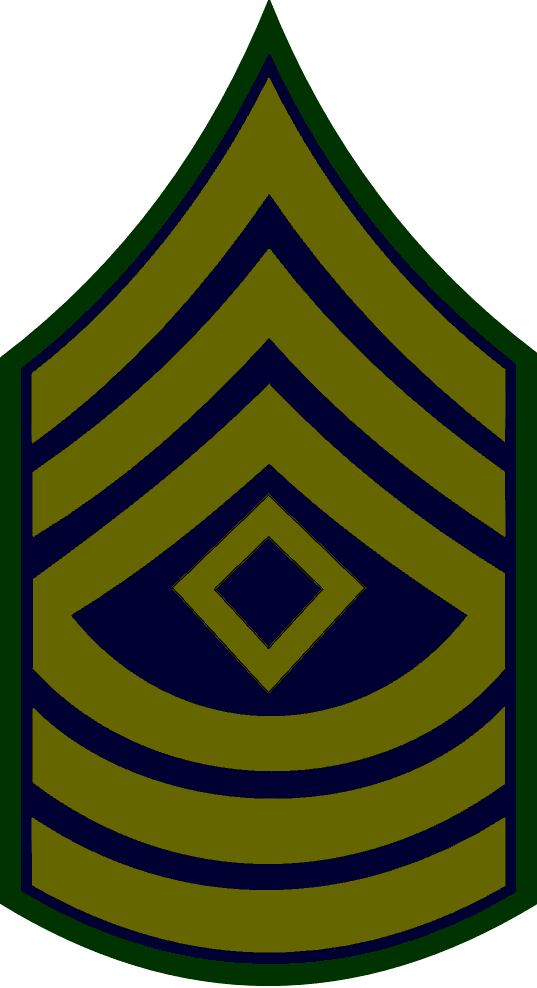
| 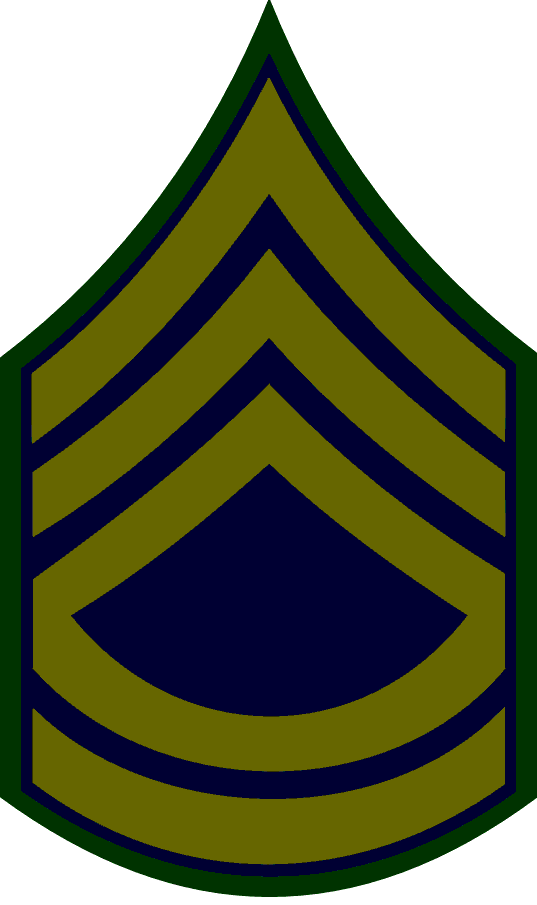
| 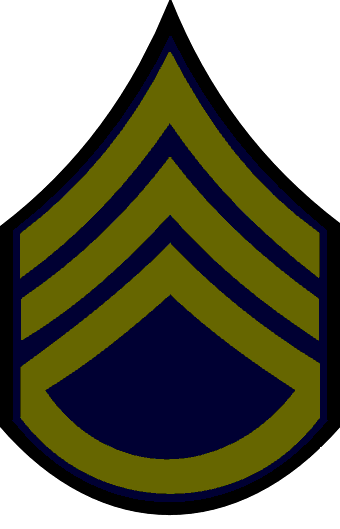
| 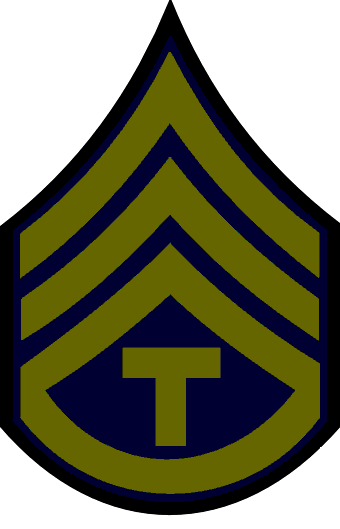
| Master Sergeant
(Grade 1) | First Sergeant
(Grade 1) | Technical Sergeant
(Grade 2) | Staff
Sergeant
(Grade 3) | Tech
3d Class
(Grade 3) | 
| 
| 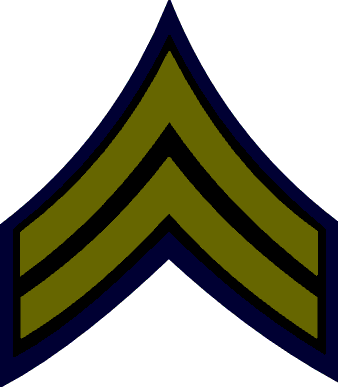
| 
| 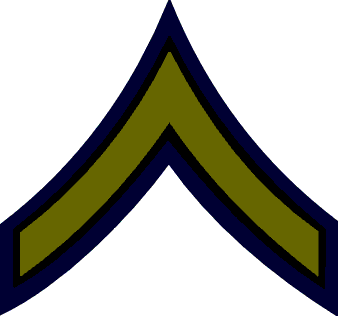
| Sergeant
(Grade 4) | Tech 4th Class
(Grade 4) | Corporal
(Grade 5) | Tech
5th Class
(Grade 5) | Private First Class
(Grade 6) | | | |
Top of Page |
 | |
|


